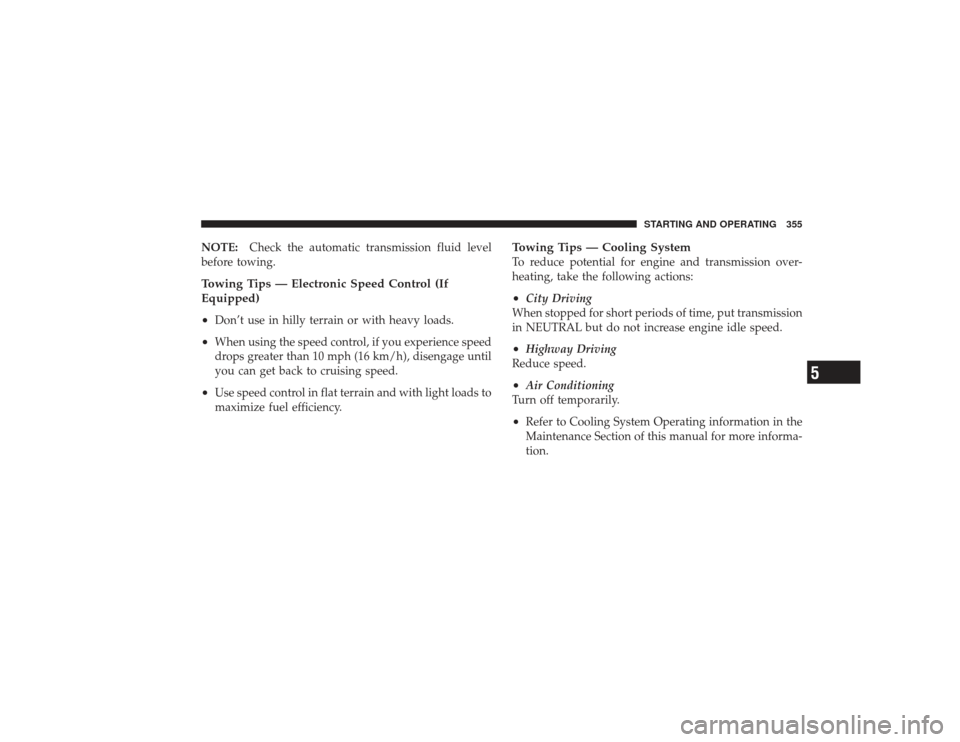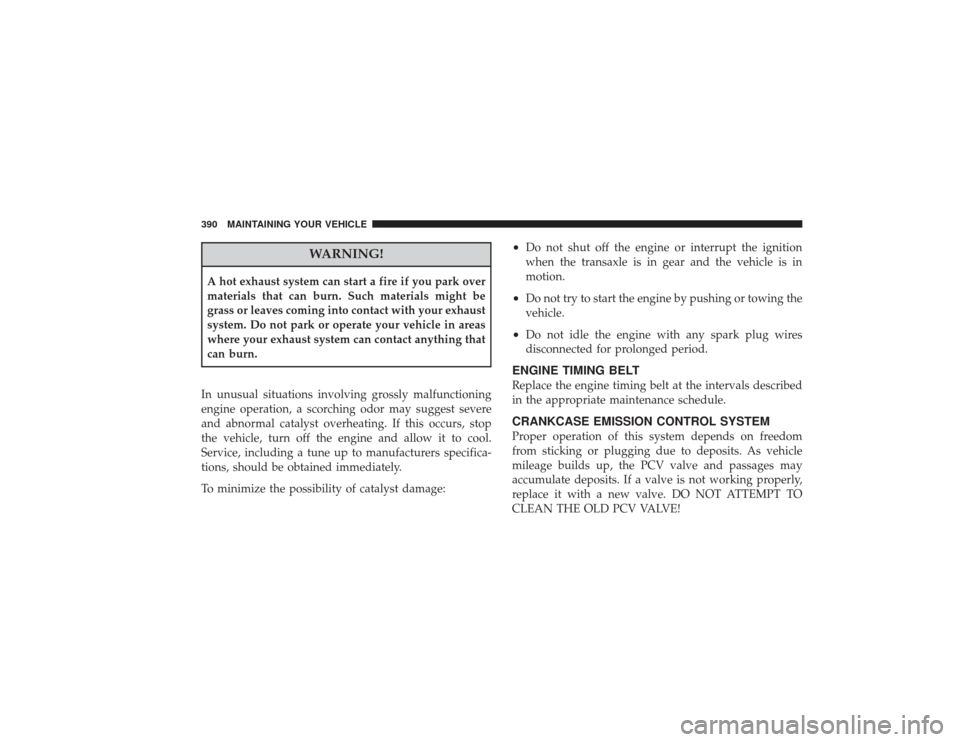stop start CHRYSLER PT CRUISER 2008 1.G Owner's Guide
[x] Cancel search | Manufacturer: CHRYSLER, Model Year: 2008, Model line: PT CRUISER, Model: CHRYSLER PT CRUISER 2008 1.GPages: 491, PDF Size: 7.08 MB
Page 357 of 491

NOTE:Check the automatic transmission fluid level
before towing.Towing Tips — Electronic Speed Control (If
Equipped)
•
Don’t use in hilly terrain or with heavy loads.
•
When using the speed control, if you experience speed
drops greater than 10 mph (16 km/h), disengage until
you can get back to cruising speed.
•
Use speed control in flat terrain and with light loads to
maximize fuel efficiency.
Towing Tips — Cooling SystemTo reduce potential for engine and transmission over-
heating, take the following actions:•
City Driving
When stopped for short periods of time, put transmission
in NEUTRAL but do not increase engine idle speed.
•
Highway Driving
Reduce speed.
•
Air Conditioning
Turn off temporarily.
•
Refer to Cooling System Operating information in the
Maintenance Section of this manual for more informa-
tion.
STARTING AND OPERATING 355
5
Page 369 of 491

8. Remove the wheel blocks and lower the jack until it is
free. Stow the lug wrench, and jack in their designated
location. Secure all parts using the means provided.
WARNING!
A loose tire or jack thrown forward in a collision or
hard stop could endanger the occupants of the ve-
hicle. Always stow the jack parts and the spare tire in
the places provided. Have the deflated (flat) tire
repaired or replaced immediately.
9. Place the deflated (flat) tire in the cargo area, have the
tire repaired or replaced as soon as possible.
10. Check the tire pressure as soon as possible. Correct
pressure as required.
JUMP-STARTING PROCEDURES DUE TO A LOW
BATTERY
WARNING!
Take care to avoid the radiator cooling fan whenever
the hood is raised. It can start anytime the ignition
switch is on. You can be hurt by the fan.
WHAT TO DO IN EMERGENCIES 367
6
Page 386 of 491

MAINTENANCE PROCEDURESThe pages that follow contain therequiredmaintenance
services determined by the engineers who designed your
vehicle.
Besides the maintenance items for which there are fixed
maintenance intervals, there are other items that should
operate satisfactorily without periodic maintenance.
However, if a malfunction of these items does occur, it
could adversely affect the engine or vehicle performance.
These items should be inspected if a malfunction is
observed or suspected.ENGINE OIL
Checking Oil LevelTo assure proper engine lubrication, the engine oil must
be maintained at the correct level. Check the oil level at
regular intervals, such as every fuel stop. The best time to check the engine oil level is about five
minutes after a fully warmed engine is shut off. Do not
check oil level before starting the engine after it has sat
overnight. Checking engine oil level when the engine is
cold will give you an incorrect reading.
Engine Oil Dipstick
384 MAINTAINING YOUR VEHICLE
Page 392 of 491

WARNING!
A hot exhaust system can start a fire if you park over
materials that can burn. Such materials might be
grass or leaves coming into contact with your exhaust
system. Do not park or operate your vehicle in areas
where your exhaust system can contact anything that
can burn.
In unusual situations involving grossly malfunctioning
engine operation, a scorching odor may suggest severe
and abnormal catalyst overheating. If this occurs, stop
the vehicle, turn off the engine and allow it to cool.
Service, including a tune up to manufacturers specifica-
tions, should be obtained immediately.
To minimize the possibility of catalyst damage:
•
Do not shut off the engine or interrupt the ignition
when the transaxle is in gear and the vehicle is in
motion.
•
Do not try to start the engine by pushing or towing the
vehicle.
•
Do not idle the engine with any spark plug wires
disconnected for prolonged period.
ENGINE TIMING BELTReplace the engine timing belt at the intervals described
in the appropriate maintenance schedule.CRANKCASE EMISSION CONTROL SYSTEMProper operation of this system depends on freedom
from sticking or plugging due to deposits. As vehicle
mileage builds up, the PCV valve and passages may
accumulate deposits. If a valve is not working properly,
replace it with a new valve. DO NOT ATTEMPT TO
CLEAN THE OLD PCV VALVE!
390 MAINTAINING YOUR VEHICLE